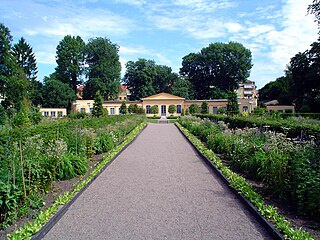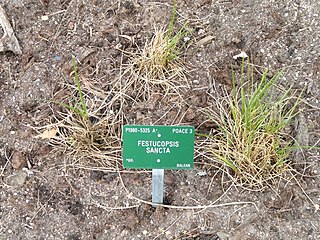
Genus is a taxonomic rank above species and below family as used in the biological classification of living and fossil organisms as well as viruses. In binomial nomenclature, the genus name forms the first part of the binomial species name for each species within the genus.

Family is one of the nine major hierarchical taxonomic ranks in Linnaean taxonomy. It is classified between order and genus. A family may be divided into subfamilies, which are intermediate ranks between the ranks of family and genus. The official family names are Latin in origin; however, popular names are often used: for example, walnut trees and hickory trees belong to the family Juglandaceae, but that family is commonly referred to as the "walnut family".

The International Code of Nomenclature for algae, fungi, and plants is the set of rules and recommendations dealing with the formal botanical names that are given to plants, fungi and a few other groups of organisms, all those "traditionally treated as algae, fungi, or plants". It was formerly called the International Code of Botanical Nomenclature (ICBN); the name was changed at the International Botanical Congress in Melbourne in July 2011 as part of the Melbourne Code which replaced the Vienna Code of 2005.

A botanical name is a formal scientific name conforming to the International Code of Nomenclature for algae, fungi, and plants (ICN) and, if it concerns a plant cultigen, the additional cultivar or Group epithets must conform to the International Code of Nomenclature for Cultivated Plants (ICNCP). The code of nomenclature covers "all organisms traditionally treated as algae, fungi, or plants, whether fossil or non-fossil, including blue-green algae (Cyanobacteria), chytrids, oomycetes, slime moulds and photosynthetic protists with their taxonomically related non-photosynthetic groups ."
Nomenclature codes or codes of nomenclature are the various rulebooks that govern the naming of living organisms. Standardizing the scientific names of biological organisms allows researchers to discuss findings.
In botany, the correct name according to the International Code of Nomenclature for algae, fungi, and plants (ICN) is the one and only botanical name that is to be used for a particular taxon, when that taxon has a particular circumscription, position and rank. Determining whether a name is correct is a complex procedure. The name must be validly published, a process which is defined in no less than 16 Articles of the ICN. It must also be "legitimate", which imposes some further requirements. If there are two or more legitimate names for the same taxon, then the correct name is the one which has priority, i.e. it was published earliest, although names may be conserved if they have been very widely used. Validly published names other than the correct name are called synonyms. Since taxonomists may disagree as to the circumscription, position or rank of a taxon, there can be more than one correct name for a particular plant. These may also be called synonyms.
In botany, an infraspecific name is the scientific name for any taxon below the rank of species, i.e. an infraspecific taxon or infraspecies. A "taxon", plural "taxa", is a group of organisms to be given a particular name. The scientific names of botanical taxa are regulated by the International Code of Nomenclature for algae, fungi, and plants (ICN). This specifies a three part name for infraspecific taxa, plus a connecting term to indicate the rank of the name. An example of such a name is Astrophytum myriostigma subvar. glabrum, the name of a subvariety of the species Astrophytum myriostigma.
In botanical nomenclature, author citation is the way of citing the person or group of people who validly published a botanical name, i.e. who first published the name while fulfilling the formal requirements as specified by the International Code of Nomenclature for algae, fungi, and plants (ICN). In cases where a species is no longer in its original generic placement, both the authority for the original genus placement and that for the new combination are given.
Werner Rodolfo Greuter is a botanist. He is the chair of the Editorial Committee for the International Code of Botanical Nomenclature (ICBN) - the Tokyo Code (1994) and the St Louis Code (2000). His proposed policy as regards registration of botanical names proved unpopular and in 1999 he stepped back, not being elected anew: he completed his term as chair to be succeeded at Vienna in 2005. He has returned as a member of the editorial committee, contributing to the renamed International Code of Nomenclature for algae, fungi, and plants, the "Melbourne Code" (2012).

Ripogonum is a genus of flowering plants confined to eastern Australia, New Zealand, and New Guinea. Until recently this genus was included in the family Smilacaceae, and earlier in the family Liliaceae, but it has now been separated as its own family Ripogonaceae.

A conserved name or nomen conservandum is a scientific name that has specific nomenclatural protection. That is, the name is retained, even though it violates one or more rules which would otherwise prevent it from being legitimate. Nomen conservandum is a Latin term, meaning "a name to be conserved". The terms are often used interchangeably, such as by the International Code of Nomenclature for Algae, Fungi, and Plants (ICN), while the International Code of Zoological Nomenclature favours the term "conserved name".
In botanical nomenclature, autonyms are automatically created names, as regulated by the International Code of Nomenclature for algae, fungi, and plants that are created for certain subdivisions of genera and species, those that include the type of the genus or species. An autonym might not be mentioned in the publication that creates it as a side-effect. Autonyms "repeat unaltered" the genus name or species epithet of the taxon being subdivided, and no other name for that same subdivision is validly published. For example, Rubus subgenus Eubatus is not validly published, and the subgenus is known as Rubus subgen. Rubus.

This is a list of terms and symbols used in scientific names for organisms, and in describing the names. For proper parts of the names themselves, see List of Latin and Greek words commonly used in systematic names. Note that many of the abbreviations are used with or without a stop.
In botanical nomenclature, a validly published name is a name that meets the requirements in the International Code of Nomenclature for algae, fungi, and plants for valid publication. Valid publication of a name represents the minimum requirements for a botanical name to exist: terms that appear to be names but have not been validly published are referred to in the ICN as "designations".
Authors of Plant Names by Richard Kenneth Brummitt and C. Emma Powell, 1992, is a print database of accepted standardized abbreviations used for citing the author who validly published the name of a taxon. The database is now maintained online at the International Plant Names Index. The book provides recommended abbreviations for authors' names that help to distinguish authors with the same surname when giving the full name of a taxon. It deals authors who validly published the name of a flowering plant, gymnosperm, fern, bryophyte, algae, fungi or fossil plants. Prior to its publication in 1992, many abbreviations for authors to be cited could be found in Taxonomic literature. A selective guide to botanical publications and collections with dates, commentaries and types. by F. A. Stafleu & R. F. Cowen, 1976–1988.

Peridictyon is a name that has been used for a genus of grass with a single species, Peridictyon sanctumnom. inval., native to southern Bulgaria and northern Greece, but a technical problem with the publication means that it is not a botanical name.
The Kew Rule was used by some authors to determine the application of synonymous names in botanical nomenclature up to about 1906, but was and still is contrary to codes of botanical nomenclature including the International Code of Nomenclature for algae, fungi, and plants. Index Kewensis, a publication that aimed to list all botanical names for seed plants at the ranks of species and genus, used the Kew Rule until its Supplement IV was published in 1913.

Sandra Diane Knapp is an American-born botanist. She is a merit researcher of the Plants Division of the Natural History Museum, London and from 2018 was the president of the Linnean Society of London. While working at the Natural History Museum, London she has overseen the Flora Mesoamericana inventory of Central American plants. She has published several books on botanical subjects as well as a significant number of scientific articles. In 2016 she was awarded the Linnean Medal. In 2022 she was elected as a Fellow of the Royal Society. In 2023 she was appointed an Officer of the Order of the British Empire (OBE) and was awarded the Engler Medal in Gold by the International Association for Plant Taxonomy.

The Interim Register of Marine and Nonmarine Genera (IRMNG) is a taxonomic database which attempts to cover published genus names for all domains of life, from 1758 in zoology up to the present, arranged in a single, internally consistent taxonomic hierarchy, for the benefit of Biodiversity Informatics initiatives plus general users of biodiversity (taxonomic) information. In addition to containing just over 500,000 published genus name instances as at May 2023, the database holds over 1.7 million species names, although this component of the data is not maintained in as current or complete state as the genus-level holdings. IRMNG can be queried online for access to the latest version of the dataset and is also made available as periodic snapshots or data dumps for import/upload into other systems as desired. The database was commenced in 2006 at the then CSIRO Division of Marine and Atmospheric Research in Australia and, since 2016, has been hosted at the Flanders Marine Institute (VLIZ) in Belgium.

Taxon is a bimonthly peer-reviewed scientific journal covering plant taxonomy. It is published by Wiley on behalf of the International Association for Plant Taxonomy, of which it is the official journal. It was established in 1952 and is the only place where nomenclature proposals and motions to amend the International Code of Nomenclature for algae, fungi, and plants can be published. The editor-in-chief is Dirk C. Albach.










